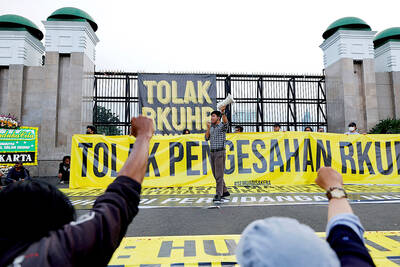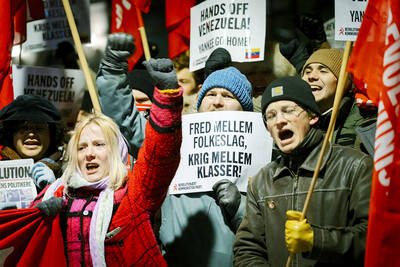To hear North Korea's state media tell it, in the midst of an inferno of exploding rail cars and dying children, several heroic women made the ultimate sacrifice, running into blazing buildings in frantic attempts to save treasured portraits of Kim Jong-il and his late father, Kim Il-sung.
"Many people of the county evacuated portraits before searching after their family members or saving their household goods," the Korean Central News Agency wrote approvingly from Ryongchon, the railroad town where a huge explosion killed at least 161 people and wounded 1,300 last week.
"They were buried under the collapsing building to die a heroic death as they were trying to come out with portraits of President Kim Il-sung and leader Kim Jong-il," it said.
In North Korea, where the state personality cult is stronger than in Mao Zedong's (
A staple of North Korea's propaganda mythology, tales of people sacrificing themselves for portraits of Kim Jong-il, known as the Dear Leader, are being reissued at a time when speculation unleashed by the explosion is swirling.
For starters, where is the Dear Leader?
One week after the blast, the state media has not chronicled any new doings by North Korea's secretive leader. Admittedly, Kim lives a Wizard of Oz existence. In his 30 years of political life and 10 years as supreme leader, he is not known to have given a public speech. To prevent assassination attempts, the North Korean media never give clues as to where he is or will be.
On April 21, Chinese state television reported that he had just left Beijing for home; everyone knows it is a 12-hour train ride to Pyongyang.
South Korean reports said his train passed through Ryongchon before dawn on Thursday, about eight hours before the blast.
In the days after the blast, reporters in Dandong, on the Chinese border, said Kim's entourage had been joined by a decoy train when he crossed the border into North Korea, a standard safety precaution.
Another nagging question: what caused the blast? Without citing a source or witness, KCNA, the North Korean news agency, said the "explosion was caused by the contact of electric lines during the shunt of wagons loaded with nitric ammonium fertilizer and tank wagons." This explosion, KCNA said, was "equivalent to the blast of about 100 bombs each weighing one tonne."
How that information could be known remains unclear. Photographs and accounts of foreign aid workers allowed to tour the scene give a picture of total devastation, deep craters surrounded by hundreds of yards of debris and desolation. It is unlikely that any witness to the ignition could have survived the blast.
Children accounted for almost half the death toll. About 500 of the 1,300 people wounded were blinded; scores of them were children, according to foreign aid workers who toured hospital wards in Sinuiju, the regional center. Some analysts have speculated that the children might have been lined up to wave at the train of a passing dignitary.
"So let's ask why half the casualties were kids and why so many of them have facial/eye injuries," Robyn Lim, a conservative military analyst in Japan, wrote.

Indonesia yesterday began enforcing its newly ratified penal code, replacing a Dutch-era criminal law that had governed the country for more than 80 years and marking a major shift in its legal landscape. Since proclaiming independence in 1945, the Southeast Asian country had continued to operate under a colonial framework widely criticized as outdated and misaligned with Indonesia’s social values. Efforts to revise the code stalled for decades as lawmakers debated how to balance human rights, religious norms and local traditions in the world’s most populous Muslim-majority nation. The 345-page Indonesian Penal Code, known as the KUHP, was passed in 2022. It

‘DISRESPECTFUL’: Katie Miller, the wife of Trump’s most influential adviser, drew ire by posting an image of Greenland in the colors of the US flag, captioning it ‘SOON’ US President Donald Trump on Sunday doubled down on his claim that Greenland should become part of the US, despite calls by the Danish prime minister to stop “threatening” the territory. Washington’s military intervention in Venezuela has reignited fears for Greenland, which Trump has repeatedly said he wants to annex, given its strategic location in the arctic. While aboard Air Force One en route to Washington, Trump reiterated the goal. “We need Greenland from the standpoint of national security, and Denmark is not going to be able to do it,” he said in response to a reporter’s question. “We’ll worry about Greenland in

PERILOUS JOURNEY: Over just a matter of days last month, about 1,600 Afghans who were at risk of perishing due to the cold weather were rescued in the mountains Habibullah set off from his home in western Afghanistan determined to find work in Iran, only for the 15-year-old to freeze to death while walking across the mountainous frontier. “He was forced to go, to bring food for the family,” his mother, Mah Jan, said at her mud home in Ghunjan village. “We have no food to eat, we have no clothes to wear. The house in which I live has no electricity, no water. I have no proper window, nothing to burn for heating,” she added, clutching a photograph of her son. Habibullah was one of at least 18 migrants who died

Russia early yesterday bombarded Ukraine, killing two people in the Kyiv region, authorities said on the eve of a diplomatic summit in France. A nationwide siren was issued just after midnight, while Ukraine’s military said air defenses were operating in several places. In the capital, a private medical facility caught fire as a result of the Russian strikes, killing one person and wounding three others, the State Emergency Service of Kyiv said. It released images of rescuers removing people on stretchers from a gutted building. Another pre-dawn attack on the neighboring city of Fastiv killed one man in his 70s, Kyiv Governor Mykola